Using the Possible: Photobiomodulation's Duty in Cells Regrowth
Wiki Article
Unlocking the Prospective of Photobiomodulation: A Promising Strategy for Therapeutic Intervention
Are you interested about the capacity of photobiomodulation for restorative treatment? Envision a circumstance where a person struggling with persistent discomfort finds relief with a non-invasive therapy that makes use of light. This is exactly what photobiomodulation offers. It is an appealing technique that harnesses the power of light to stimulate healing and minimize swelling in numerous clinical problems. By targeting specific cellular processes, photobiomodulation has shown potential in speeding up injury recovery, lowering discomfort, and advertising cells regrowth. In this intro, we will certainly discover the mechanisms of activity, applications in medication, and the existing proof supporting the efficiency of photobiomodulation. Furthermore, we will review future directions and possible obstacles in opening its full potential as a restorative treatment.Understanding Photobiomodulation
To recognize photobiomodulation, you need to grasp the idea of exactly how light treatment can straight influence mobile procedures in your body. Photobiomodulation, additionally recognized as low-level light therapy, is a non-invasive treatment that uses particular wavelengths of light to stimulate biochemical responses in your cells. When exposed to these light wavelengths, your cells take in the power and convert it right into cellular energy, referred to as adenosine triphosphate (ATP) This rise in ATP production brings about a cascade of mobile actions, including boosted metabolism, enhanced circulation, and enhanced production of collagen and various other proteins.The healing impacts of photobiomodulation are far-ranging and have been researched extensively in different clinical fields. It has actually revealed promising outcomes in promoting tissue repair and regeneration, lowering inflammation, relieving pain, and boosting injury healing. Photobiomodulation has been discovered to have a favorable influence on neurological conditions, such as distressing mind injury and stroke, by stimulating neural activity and advertising neuroplasticity.
One of the crucial benefits of photobiomodulation is its safety and security account. Unlike other therapies, photobiomodulation does not cause or produce any kind of warmth tissue damages. It is a non-invasive and painless procedure that can be performed in a clinical setup or even in the convenience of your very own home with using portable tools. However, it is necessary to keep in mind that photobiomodulation should be carried out by experienced experts or according to the supplier's guidelines to ensure optimal outcomes and safety.

Systems of Action
In understanding the devices of action, you will uncover exactly how photobiomodulation directly affects mobile processes via certain biochemical reactions. When light is used to the body, it is taken in by chromophores, such as cytochrome c oxidase and flavins, which are present in the mitochondria. This absorption brings about a waterfall of events that inevitably cause mobile modifications.Among the crucial mechanisms of activity is the excitement of ATP manufacturing. Photobiomodulation enhances the task of cytochrome c oxidase, a crucial enzyme in the mitochondria that is entailed in the electron transport chain. This increased task results in the manufacturing of even more ATP, the primary power money of the cell. Consequently, cellular metabolic rate is boosted, advertising tissue repair work and regeneration.
In addition, photobiomodulation has been shown to regulate mobile signaling pathways. It turns on various growth variables and signaling molecules, such as nitric oxide and responsive oxygen varieties, which play important functions in procedures like inflammation, angiogenesis, and cell proliferation. These signaling pathways add to the healing results of photobiomodulation, promoting tissue healing and minimizing discomfort and swelling.
Applications in Medicine
Explore the varied applications of photobiomodulation in medication. Photobiomodulation, additionally called low-level light therapy, is a non-invasive treatment that utilizes light to advertise and boost mobile procedures healing. In medicine, this method has actually revealed appealing outcomes throughout different fields.One of the primary applications of photobiomodulation is in pain management. photobiomodulation laser. It has been used to alleviate both acute and chronic discomfort, consisting of bone and joint problems, neuropathic pain, and post-operative pain. By targeting the affected area with specific wavelengths of light, photobiomodulation can reduce inflammation, advertise cells fixing, and supply alleviation
Furthermore, photobiomodulation has shown possible in injury recovery. It can increase the recovery process by enhancing cell proliferation, advertising angiogenesis, and minimizing scar tissue development. This has substantial effects in the treatment of persistent injuries, such as diabetic ulcers and stress sores.
In dermatology, photobiomodulation has actually been utilized for its regenerative and anti-inflammatory effects. It can enhance the look of marks, lower acne lesions, and promote hair growth in conditions like androgenetic alopecia.
Moreover, photobiomodulation has actually revealed promise in neurorehabilitation. It can improve cognitive feature, boost electric motor recuperation, see here now and help in the therapy of neurodegenerative diseases like Alzheimer's and Parkinson's.
Professional Evidence and Study Findings

In the field of bone and joint disorders, photobiomodulation has been located to decrease discomfort and swelling, enhance variety of motion, and speed up cells repair work. Studies have shown its effectiveness in dealing with problems such as osteoarthritis, tendinopathies, and muscle strains. Additionally, photobiomodulation has shown positive results on injury recovery by promoting collagen fibroblast, angiogenesis, and synthesis proliferation. This makes it a beneficial tool in the monitoring of chronic injuries, diabetic person ulcers, and surgical lacerations.
Furthermore, research study has shown that photobiomodulation can have neuroprotective and neuroregenerative effects. It has actually been located to boost cognitive feature, decrease neuroinflammation, and improve neuronal survival and synaptic plasticity. This has vital effects for the therapy of neurological problems such as Alzheimer's disease, Parkinson's illness, and stroke.
Future Directions and Possible Difficulties
Progressing, it is very important to consider the future instructions and prospective challenges surrounding making use of photobiomodulation as a therapeutic intervention. One vital future instructions is the exploration and optimization of application specifications. Currently, there is no agreement on the ideal wavelength, intensity, period, and frequency of photobiomodulation treatment. More research study is required to recognize the dose-response connection and develop evidence-based standards for medical practice.One more essential future instructions is the development of cost-efficient and portable photobiomodulation tools. While current gadgets work, they are commonly large, expensive, and need specialist supervision - photobiomodulation. The advancement of economical and straightforward devices would considerably boost availability to this treatment, allowing more people to take advantage of its potential restorative impacts
In addition, future research ought to focus on illuminating the devices underlying photobiomodulation. Regardless of its growing popularity, the precise systems through which photobiomodulation applies its healing effects are not fully understood. Comprehending these devices would certainly not just boost our knowledge of the therapy but also aid in the development of more targeted and effective interventions.
However, there are likewise prospective difficulties that need to be attended to. photobiomodulation laser. These consist of the demand for standard procedures, the demand for properly designed professional tests with bigger sample sizes, and the need for long-term follow-up studies. Regulative and safety factors to consider have to be taken right into account to guarantee the reliable and risk-free use of photobiomodulation in clinical technique.
Conclusion
In verdict, photobiomodulation holds great assurance as a therapeutic intervention in medication. Its mechanisms of action and medical evidence suggest its prospective for dealing with numerous problems. Nevertheless, additional study is needed to fully recognize its advantages and attend to any type of possible challenges. With ongoing research studies and developments in this area, photobiomodulation has the prospective to open new opportunities for improving client end results.Are you interested concerning the potential of photobiomodulation for therapeutic intervention? By targeting particular mobile procedures, photobiomodulation has actually revealed possible in increasing injury recovery, reducing pain, and promoting tissue regeneration.Furthermore, photobiomodulation has shown prospective in wound healing.Moving forward, it is essential to think about the prospective difficulties Visit This Link and future directions surrounding the use of photobiomodulation as a therapeutic intervention. With ongoing researches and innovations in this area, photobiomodulation has the possible to open new possibilities for improving patient outcomes.
Report this wiki page